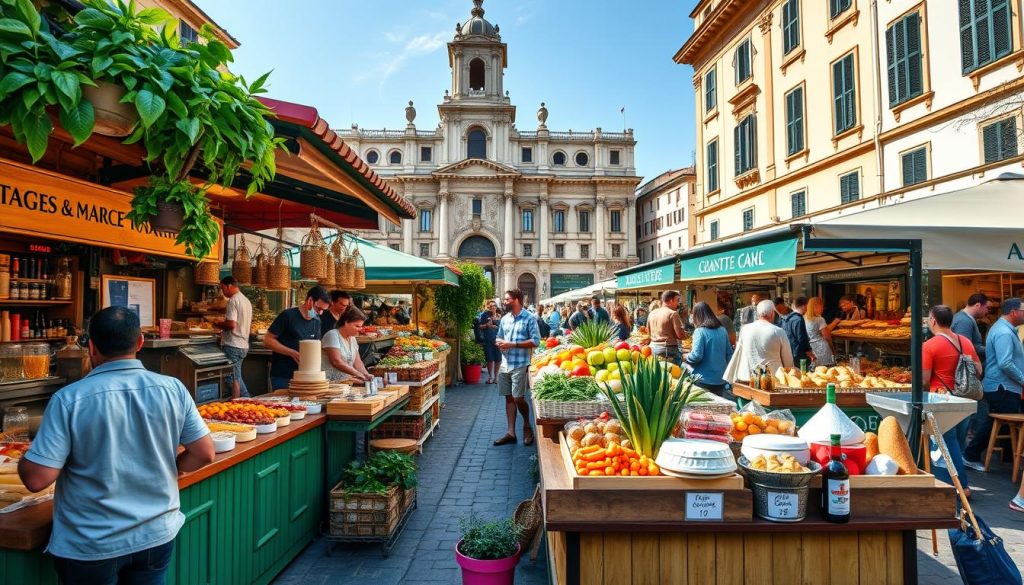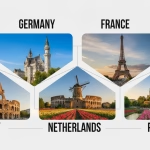Italy is famous for its food and is full of chances for new business owners. It mixes old traditions with new ideas, making it perfect for food and drink businesses. The food and drink sector is a big part of Italy’s exports, making it a great time to start something new.
- Emerging Food Trends in Italy
- The Rich Gastronomy of Italy
- Food and Beverage Business Ideas in Italy
- Starting a Food Truck in Italy
- Opening an Ice Cream Shop: A Sweet Venture
- Cooking Classes: Blending Tradition with Innovation
- Launching a Personal Chef Service
- Starting a Coffee Shop: A Daily Essential
- Meal Kits: Convenience Meets Quality
- Exploring the World of Baked Goods in Italy
- Utilising Traditional Italian Sauces for a Niche Market
- Prepackaged Snacks: A Business Opportunity
- Organic Food Products: Meeting Growing Demand
- Cultivating a Wine or Craft Beer Business
- Crafting Unique Homemade Jams and Jellies
- Sustainable Practices in the Food Industry
Italian food and drinks are loved by people at home and visitors alike. This makes Italy a key player in the world’s food market. The industry is growing, offering many business ideas, from food trucks to coffee shops. These ideas capture the true taste and culture of Italy.
Key Takeaways
- Italy’s food and beverage sector accounts for over 30% of total exports, highlighting immense potential.
- Innovative food ventures can cater to both local and tourist markets effectively.
- The growth of food trucks offers a flexible model within the competitive food business industry.
- Artisan coffee shops are on the rise, driven by increasing consumer demand for quality.
- Embracing Italy’s rich culinary traditions can lead to unique business opportunities.
- Entrepreneurs can leverage the popularity of meal kits by providing convenience and quality.
- Investment in the food and beverage sector can yield profitable returns backed by robust export values.
Emerging Food Trends in Italy
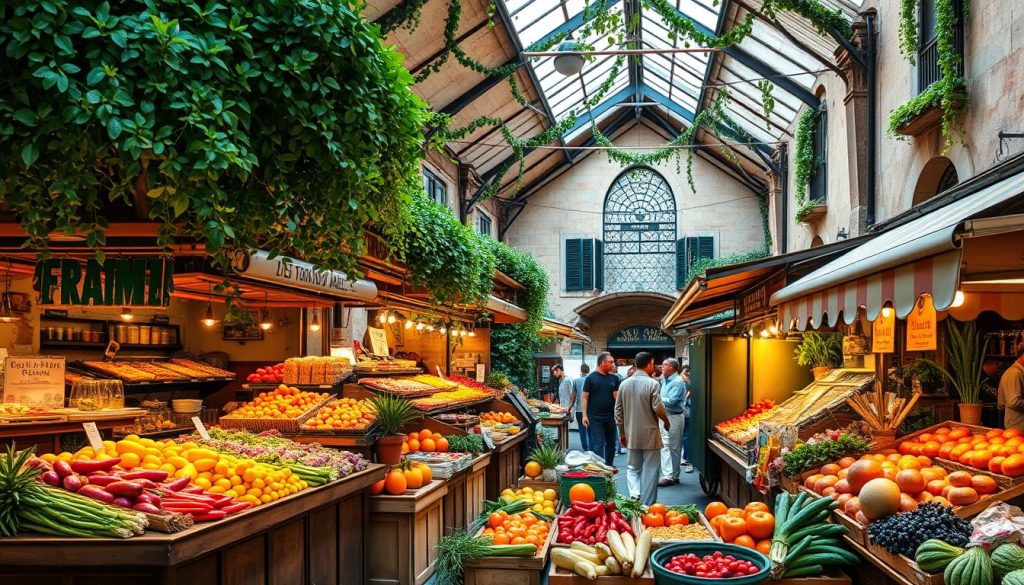
Italy’s food sector is changing fast, with a focus on health and sustainability. More people want plant-based foods, thanks to health concerns. Mintel’s research shows that people now look for a balance between healthy and tasty food.
This shift is leading to new food options, like ghost kitchens and virtual restaurants. These changes show how the food world is adapting to what people want. There’s also a growing interest in foods that are good for you, like functional foods.
Businesses are now focusing on sustainable packaging to meet these demands.
New Italian restaurants are popping up in big U.S. cities. Italian food is becoming more popular, with unique dishes and diverse desserts. This shows a growing interest in trying new things when eating out.
The food industry is evolving, and Italian cuisine is at the forefront. People now want food that’s good for them, not just tasty. This means businesses can innovate and meet these new needs.
With these trends, there’s a big chance for businesses to tap into what’s new in Italy. As people explore new tastes and origins, the food sector can offer more variety that’s both healthy and sustainable.
The Rich Gastronomy of Italy
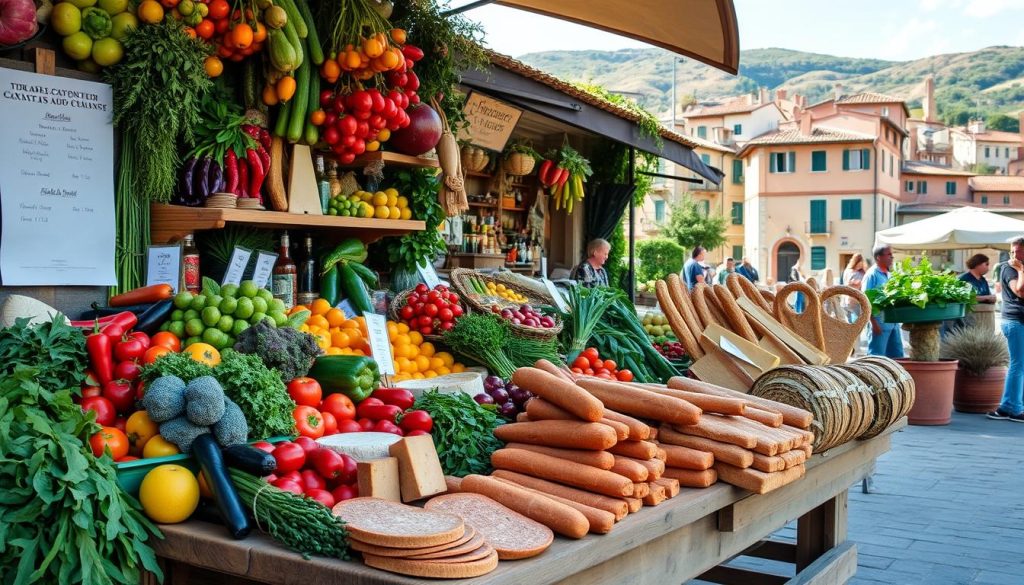
Italy’s food scene is deeply rooted in its culture and diverse regions. Each area brings its own unique tastes, ingredients, and dishes. This makes Italy a hotspot for food lovers and businesses alike.
The country’s food tourism is set to boom, with a forecasted growth from USD 44,883.6 million in 2024 to USD 153,714.1 million by 2034. This is a 13.1% annual growth rate. The rise in international tourists, expected to be 53.8% in 2024, will fuel this growth.
Restaurants are key in showcasing Italy’s rich food heritage, with a 36.2% value share in 2024. Food tours, cooking lessons, and garden-to-plate experiences are gaining popularity. These activities offer a deep dive into Italy’s culinary traditions.
Niche Italian products, like gluten-free and organic options, are becoming more popular. They cater to health-conscious consumers, offering a variety of choices.
Adding alimentari sections to restaurants is a growing trend. It lets customers buy high-quality ingredients for their own cooking. This enhances their dining experience at home.
The blending of Italian and Japanese cuisines, seen in places like Wafu, shows diners’ love for new tastes. They seek out unique flavour combinations.
Food and Beverage Business Ideas in Italy
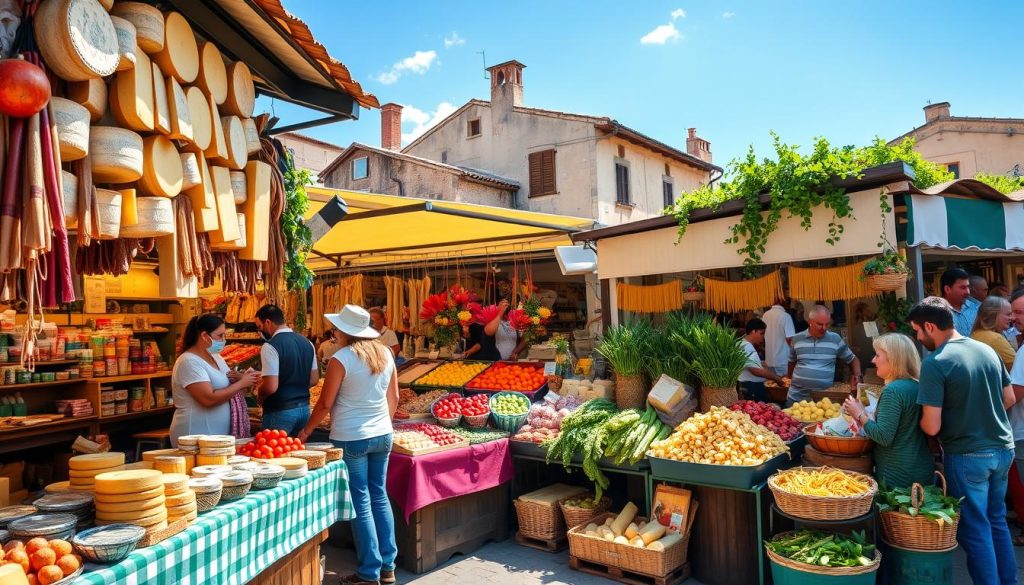
Italy is full of chances for food businesses, thanks to its rich culinary scene. Entrepreneurs can find many ventures that meet changing tastes. Artisan drinks and local wines are becoming more popular, making beverage ventures especially promising.
Starting a mobile food truck is a great idea. It’s flexible and doesn’t cost much to start. You can offer unique menus at different places and events, drawing in lots of customers. Another good idea is a personal chef service. It caters to those who want tasty meals without cooking themselves.
Ice cream shops are a big part of Italian culture. Opening one lets you mix tradition with new flavours to attract customers. Starting a cooking class is also a good idea. It lets chefs share their skills and earn money.
Italy has over 51,000 Food & Beverage companies, making it a big market. This is a great time for new businesses to offer fresh takes on classics. Being sustainable and local is key to attracting customers who care about quality and the environment.
The trend towards healthy eating and gourmet experiences is growing in Italy. This makes it a great place for food businesses that focus on these areas. By understanding what customers want, entrepreneurs can find successful niches. Italy is also a big player in food exports, showing the potential for profit.
The food and beverage sector in Italy is full of opportunities for new businesses. From mobile kitchens to unique dining experiences, there’s a lot to explore. Italy’s love for cooking and hospitality will help new businesses grow.
The chances for success in food and beverage ventures in Italy are vast and profitable. Starting a business here can be very rewarding, thanks to Italy’s passion for food and hospitality.
Starting a Food Truck in Italy
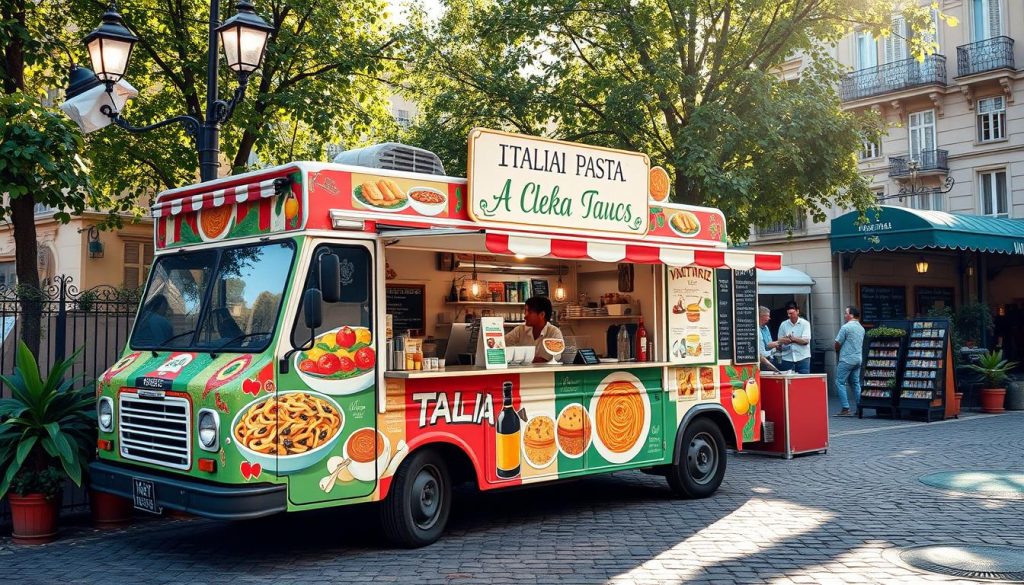
The food truck business is growing in Italy, attracting food lovers. It offers the chance to pick your hours and find the best spots. This way, you can meet different tastes and build a strong fan base.
Starting a food truck is cheaper than opening a restaurant. This makes it a great choice for those looking to save money.
In Italy, food trucks are everywhere, from city streets to parks. They serve food daily, meeting people face-to-face. They also cater to events like weddings and corporate parties.
At festivals and sports events, food trucks reach more people. This helps them grow their customer base.
There are many types of food trucks, like sandwich and pizza trucks. They add to Italy’s lively food scene. Some even serve late at night in bars and clubs.
Offering food delivery and pre-orders is also common. Cooking demos make dining more fun and build community ties.
Opening an Ice Cream Shop: A Sweet Venture
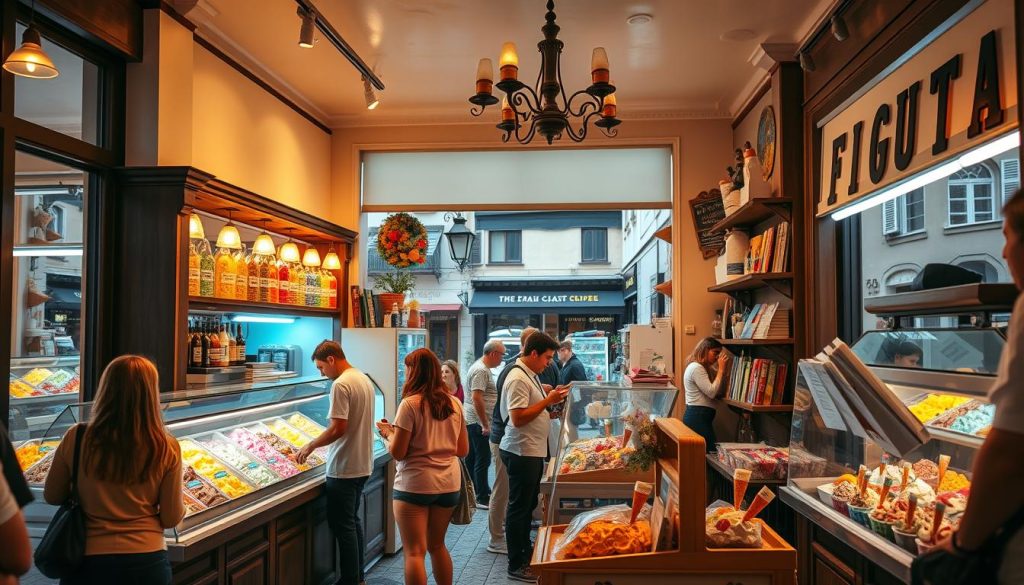
The ice cream industry is booming, especially in Italy. Here, the love for artisanal gelato is strong. The global gelato market is set to hit $135.6 billion by 2029. In 2018, it was worth USD 5.7 billion and is forecast to reach USD 9.2 billion by 2025, growing at 6.5% annually. Italy plays a big role in the European gelato market
Starting an ice cream shop in Italy lets you get creative with designs and flavours. You can offer everything from classic gelato to vegan options. This appeals to families, tourists, and health-conscious shoppers. You can change your menu with the seasons and introduce unique flavours to keep things interesting. The market is also moving towards eco-friendly and healthier options, opening up new opportunities for success.
Ice cream sales might go up and down with the seasons. But, with good marketing and a variety of products, you can stay ahead. Ideas like gelato boutiques or frozen yogurt bars are popular. They offer gourmet treats and healthier options, finding a spot in the competitive market. Highlighting your use of artisanal methods and local ingredients will attract customers who value quality. This ensures your ice cream shop does well in a changing market.
Cooking Classes: Blending Tradition with Innovation
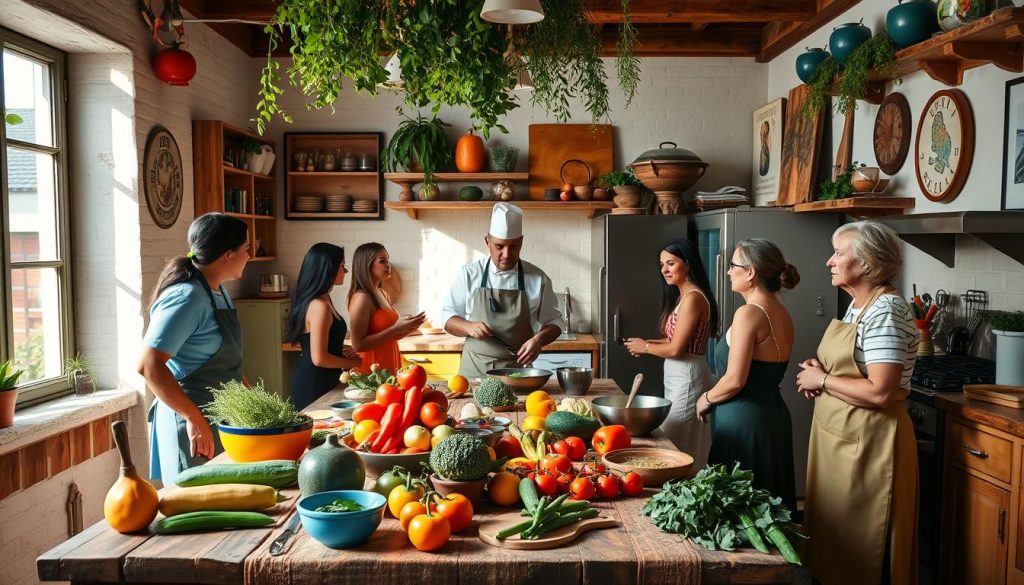
Cooking classes are a great way to learn about Italian cuisine. They offer both online and in-person options. This means more people can join, thanks to online learning’s flexibility. Yet, in-person classes help build strong bonds with customers, which is key for success.
A survey found that 67% of tourism professionals see a bright future in culinary experiences. This shows more people want to explore food during their travels.
Online vs In-Person Classes
Online cooking classes let you cook from home, perfect for those with busy lives. But, in-person classes offer a chance to meet others and learn directly from chefs. This personal interaction is crucial for building a loyal customer base.
Culinary schools teach that hands-on training is essential. It prepares students for the competitive world of cooking. Personal instruction is invaluable for their success.
Unique Class Themes
Unique themes, like local traditions or modern recipes, make classes stand out. For example, pasta-making classes highlight the skill and quality of ingredients. Otao Kitchen offers hands-on experiences that celebrate Italian cuisine’s essence.
By blending tradition and innovation, cooking classes teach the value of authentic flavours. They also encourage creativity in the kitchen.
Launching a Personal Chef Service

Starting a personal chef business lets you create meals just for your clients. You focus on what they like to eat and their dietary needs. This builds a strong bond with your clients, which is key for getting more work and recommendations.
Personal chefs can make menus that fit special diets or health goals. This makes customers very happy. You can earn between $30,000 and $100,000 a year with an initial investment of $500 to $5,000.
To succeed, you need great cooking skills and to be good at talking and organising. It’s important to listen to what your clients want and keep improving your menu. This way, you can offer top-notch service and keep your clients coming back.
However, running a personal chef service comes with its own set of challenges. You have to plan meals carefully and handle the business side of things. But, using social media or food blogs to show off your cooking can really help attract more customers.
Starting a Coffee Shop: A Daily Essential

Starting a coffee shop is a great chance to make money in the growing coffee business. More people want unique and high-quality coffee, making it a hit. Shops that offer special blends and brewing methods will attract coffee lovers.
Rising Demand for Artisan Coffee
The UK now has about 24,000 coffee shops, and this number is expected to grow to 30,000 by 2025. With people looking for top-notch drinks, coffee shops can find their own special place. Shops sell around 200 cups of coffee every day, showing there’s a big customer base to serve.
Starting a coffee shop can cost between £29,999 and £99,000, depending on where you are and what you need. Shops can make about 2.5% profit on what they sell. It might take six to twelve months to start making money and covering costs.
Creating a Unique Brand Identity
A strong brand can make your coffee shop stand out. Good branding means focusing on quality, being part of the community, and offering new things. It’s about creating a unique look and experience that customers will remember.
It’s important to do your homework before opening. Know who lives nearby, what other shops there are, and how much people spend. Your marketing should match what your shop is about and use your budget wisely. A clear plan and vision can help you succeed and attract investors.
Meal Kits: Convenience Meets Quality
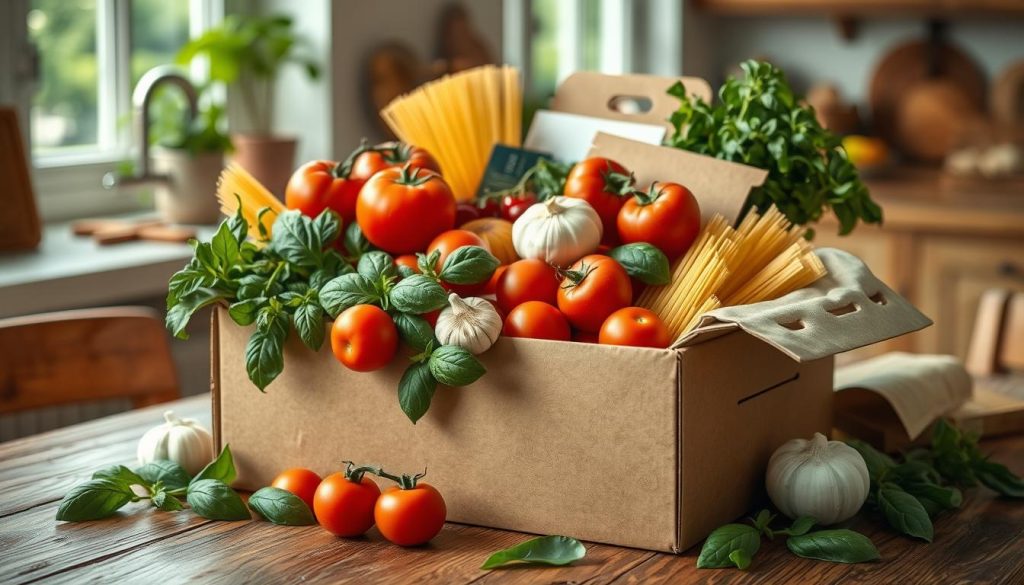
Meal kit delivery services have grown a lot in Europe, reaching USD 6.4 billion in 2023. They are expected to grow even more, with a CAGR of 11.8% from 2024 to 2030. This shows a big change towards wanting easy meal solutions without losing quality. In 2023, meal kits made up 24.5% of the global revenue.
Entrepreneurs can start meal kits for subscriptions or one-off orders, catering to different diets. In 2023, 39.7% of meal kits were for cooking and eating yourself. The heat-and-eat segment is set to grow by 11.6% in the future. Also, 63.6% of meal kits were not vegetarian, but vegan options are growing fast, at 12.9% CAGR.
For new businesses, tackling spoilage during shipping is key. The market is set to hit USD 15.7 billion by 2030. Good packaging and delivery are crucial to keep ingredients fresh. This ensures customers get top-quality products for their cooking.
The meal kit delivery market is growing, offering a great chance for culinary innovators. The market size was USD 21.03 billion in 2023. It’s expected to grow from USD 24.26 billion in 2022 to USD 63.22 billion by 2032. This shows a big move towards easier cooking and meal prep.
Exploring the World of Baked Goods in Italy
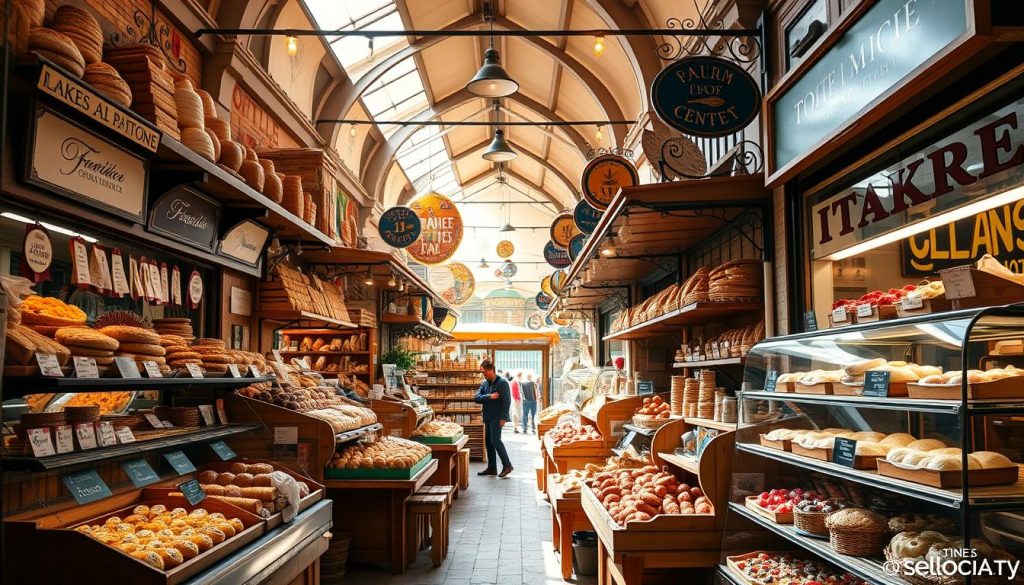
The baked goods market in Italy shows a mix of old traditions and new tastes. Artisanal baking is gaining ground, thanks to a love for unique flavours and top-notch ingredients. Today, people want healthier and handmade treats, giving bakeries a chance to stand out with their quality and creativity.
Market Trends and Consumer Preferences
Italian buyers are now looking for baked goods that taste great and are good for them. They’re choosing items made with whole grains and organic ingredients. The charm of handmade goods is also growing, thanks to the skill and care that goes into making them.
- Growth in gluten-free products, reflecting the rise of health-conscious consumers.
- Increased demand for traditional recipes that showcase regional flavours.
- Popularity of online ordering and delivery services for baked goods.
Bakeries are responding to these changes by introducing new ideas while keeping Italy’s baking traditions alive. In this competitive world, being original is key to success. It ensures that what they offer meets the tastes of today’s consumers.
Utilising Traditional Italian Sauces for a Niche Market
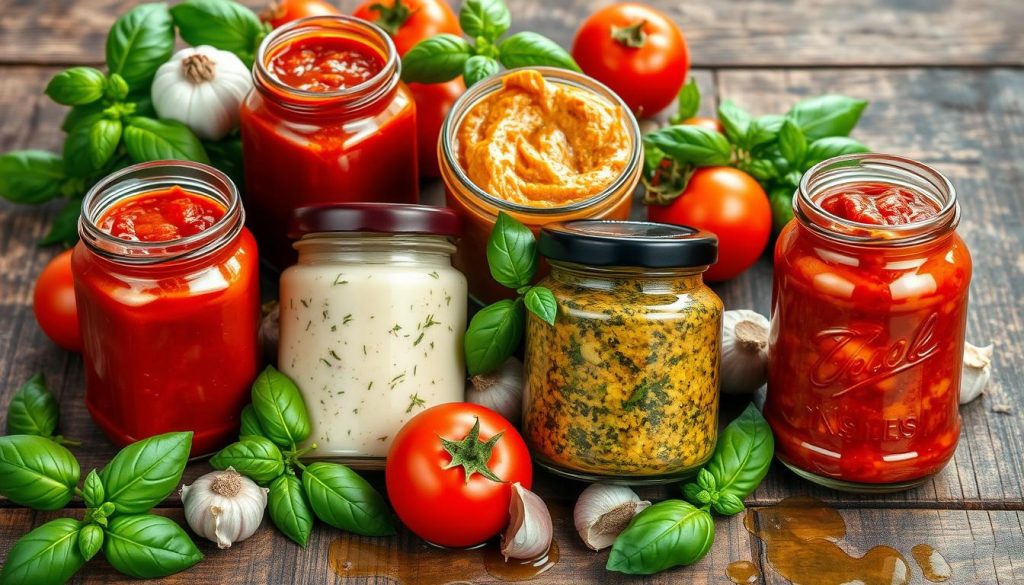
Italian sauces are a big chance for food entrepreneurs, especially in niche markets. These sauces, rooted in Italy’s rich food culture, can meet many tastes. Entrepreneurs can make pesto, marinara, and arrabbiata sauces, each appealing to different people.
In today’s market, being authentic and focusing on local specialties is key. The global Italian restaurant market is worth billions. Italian sauces made with local ingredients can attract both local and international customers. Health-focused diners want whole wheat and gluten-free pasta with lighter sauces, making innovative products in demand.
To market traditional Italian sauces well, businesses should:
- Show the care in making each sauce to attract those who value quality.
- Use attractive packaging that shows the sauce’s authenticity and quality.
- Give out samples in markets or stores to raise awareness and boost sales.
Being green is crucial in the food world. Sauce makers can highlight eco-friendly packaging and use local ingredients. This appeals to those who care about the environment. By using Italy’s deep food history, entrepreneurs can find a special place. They can offer top-notch sauces that appeal to both home and international markets.
Prepackaged Snacks: A Business Opportunity
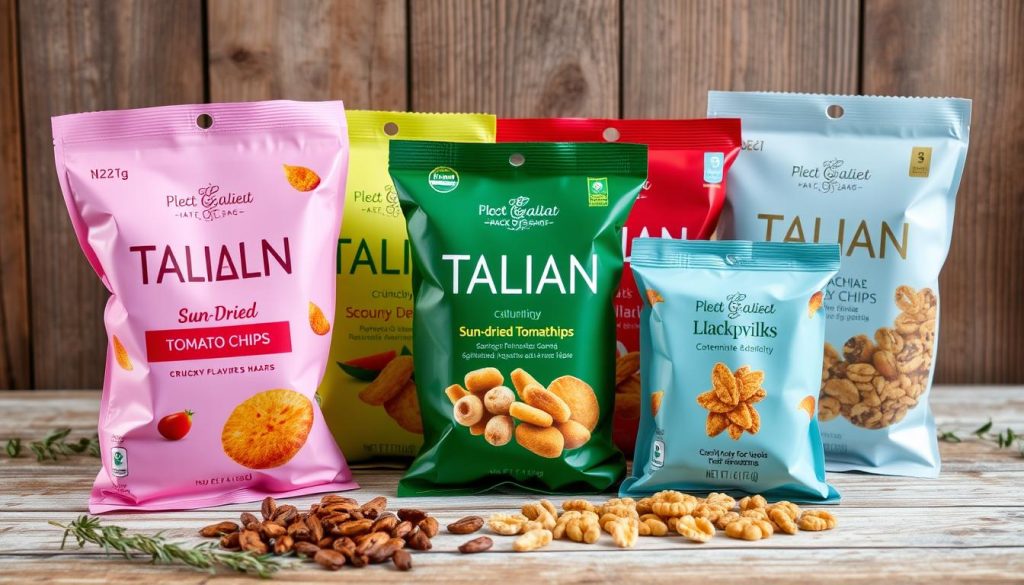
The demand for prepackaged snacks is growing fast. People want healthy, easy-to-eat foods that fit their busy lives. This trend has opened up big chances for new businesses. The candy industry alone makes over $20 billion a year, showing how profitable snacks can be.
Artisanal snacks are becoming more popular. Many brands now focus on using high-quality, natural ingredients. Starting a candy business can cost between $5,000 and $50,000, making it accessible for many. It’s also important to manage your stock well to meet customer needs.
With more people looking for special flavours and eco-friendly options, there are many niches to explore. Starting a candy shop can cost between $500 and $1,500 for initial supplies. Creating a strong brand with great packaging and marketing can help stand out in the market.
Understanding what customers want is key. Health and wellness trends play a big role in shaping snack choices. If you’re thinking of making your own snacks, you’ll need about $6,000 worth of equipment. The market is ready for innovative, healthy products.
Organic Food Products: Meeting Growing Demand
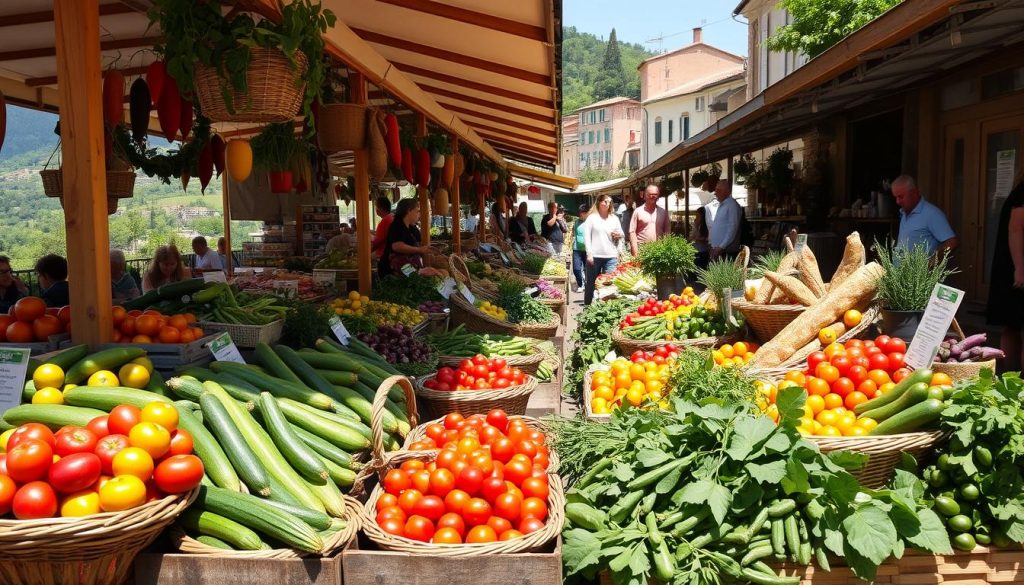
The organic food market is growing fast, thanks to people wanting healthier choices. The European food market is valued at about €1,869 billion in 2023. This includes organic products, offering a big opportunity for entrepreneurs.
Italy is the 2nd biggest market in Europe for organic food. The retail trade in this area is growing by about 1.75% each year. This shows a strong move towards sustainable and healthy choices.
Organic products meet consumer needs and support the environment. Businesses that focus on clear sourcing and sustainable farming can meet demand. They also encourage responsible consumption.
The economy is recovering, and new businesses are registering fast, with 332,596 in 2021. This is great news for entrepreneurs in the organic sector. It creates a space for innovation and products that appeal to health-conscious consumers.
Cultivating a Wine or Craft Beer Business

Italy’s wine regions and craft beer scene are booming. Places like Tuscany and Veneto are perfect for small wine businesses. Wineries and breweries find great opportunities with local ingredients and vineyards.
The craft beer scene is getting bigger. Young entrepreneurs are trying new brewing methods and using local ingredients.
Italy’s Rich Wine Regions and Craft Beer Movement
Italy’s wine business is doing well, even with tough times. Micro-wineries take time to grow grapes, but they focus on quality. Starting a wine bar can be quick and profitable.
House wines from local producers are great for wine bars. They fit well with Traditional practices.
The craft beer scene is growing fast, especially in cities like Rome and Milan. Craft beer can make up to 20% of beer sales. Breweries are opening tap-rooms and restaurants to attract more customers, especially the 21-35 age group.
They focus on unique branding and online sales. This attracts customers who love artisanal products.
Starting an online wine business can make $150,000 to $1,000,000 a month. It’s a great chance for entrepreneurs. Running a wine club can bring in $85,000 to $270,000 a month. This shows people want special wine experiences.
The craft beer industry is here to stay. It’s now part of many sales channels, like Horeca, catering, and retail. This shows its growing role in the drink world.
Crafting Unique Homemade Jams and Jellies
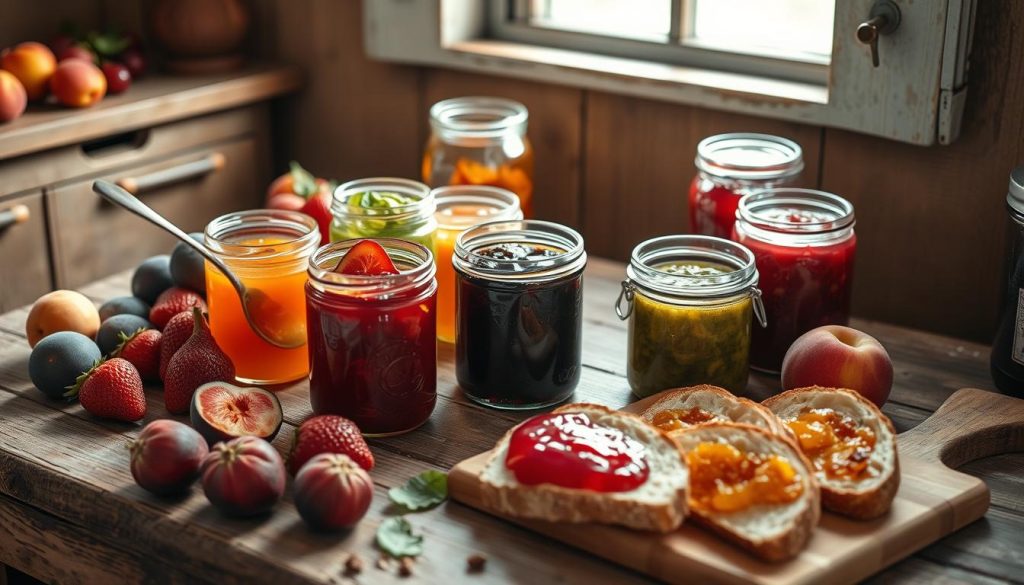
The world of homemade jams and jellies is booming. More people want to buy artisanal food made with local ingredients. Entrepreneurs can tap into this trend by using seasonal fruits and old recipes. This appeals to a growing number of picky buyers.
It’s important to pick the right local ingredients. Buying directly from farmers makes products fresher and tastier. It also builds a bond with the community. This supports local farming and adds a special story to each jar.
To make unique homemade jams, try these tips:
- Try mixing different fruits for interesting tastes.
- Add herbs and spices to enhance the fruit’s flavour.
- Use fewer preservatives to keep the natural taste of the jams.
There’s a big trend for nostalgic flavours, with 44% of global consumers loving them. By using traditional recipes, makers can connect with people who want comfort in their food. This can help entrepreneurs stand out in the competitive world of homemade jams.
Sustainable Practices in the Food Industry
As people become more aware of environmental issues, the food industry is changing. Businesses are now focusing on sustainable food practices. This shift shows a growing demand for products made with care and health in mind.
Consumers want real, artisanal goods over mass-produced ones. This change helps businesses build stronger relationships with their customers. It also attracts more people who care about the environment.
Using sustainable materials and sources can cut down on waste and save money. It also helps businesses appeal to investors who value the environment. This makes them stand out in a crowded market.
Switching to renewable energy and recycling can make businesses more efficient. It also helps reduce pollution and can even bring in new income. So, adopting these practices is good for the planet and for business.

